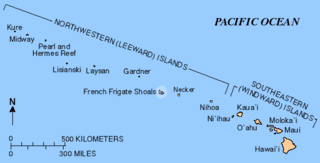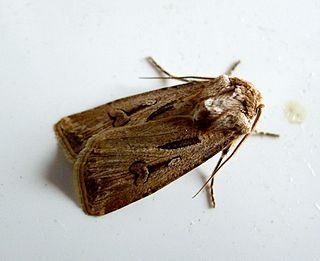
The bogong moth is a temperate species of night-flying moth, notable for its biannual long-distance seasonal migrations towards and from the Australian Alps, similar to the diurnal monarch butterfly. During the autumn and winter it is found in southern Queensland, western New South Wales, western Victoria, and also in South and Western Australia. Adult bogong moths breed and larvae hatch during this period, consuming winter pasture plants during their growth. During the spring, the moths migrate south or east and reside in mountains such as Mount Bogong, where they gregariously aestivate over the summer until their return towards breeding grounds again in the autumn.

Agrotis segetum, sometimes known as the turnip moth, is a moth of the family Noctuidae. The species was first described by Michael Denis and Ignaz Schiffermüller in 1775. It is a common European species and it is found in Africa and across Eurasia except for the northernmost parts.

The heart and dart is a moth of the family Noctuidae. The species was first described by Carl Linnaeus in his 1758 10th edition of Systema Naturae. A familiar moth to many, it is considered one of the most common of the European region. It occurs throughout the Palearctic realm from Ireland to Japan.

Agrotis is a genus of moths of the family Noctuidae. The genus was erected by Ferdinand Ochsenheimer in 1816. A number of the species of this genus are extinct.
The poko noctuid moth is a moth in the family Noctuidae. The species was first described by Arthur Gardiner Butler in 1881.

Kerr's noctuid moth is a species of moth in the family Noctuidae.

The Laysan noctuid moth is a species of moth in the family Noctuidae.

Agrotis photophila, the light-loving noctuid moth, is a species of moth in the family Noctuidae. It is endemic to Oʻahu, Hawaiʻi, United States.

The Procellaris Agrotis noctuid moth is a species of moth in the family Erebidae.
Agrotis melanoneura was a moth in the family Noctuidae. It is now an extinct species.

Agrotis microreas was a moth in the family Noctuidae. It is now an extinct species.

Agrotis panoplias, the Kona agrotis noctuid moth, is a species of moth in the family Noctuidae. It is now considered as possibly extinct.

Agrotis stigmosa is a moth of the family Noctuidae first described by Herbert Knowles Morrison in 1875. It is found in North America from New England and Quebec west to Colorado and eastern Alberta. It is listed as a species of special concern in the US state of Connecticut.

Agrotis spinifera, or Gregson's dart, is a moth of the family Noctuidae. The species was first described by Jacob Hübner in 1808. It is found in southern Europe, Arabia to southern Africa, Madagascar, Turkey, Iraq, Iran, Afghanistan, Pakistan, Kashmir, India to Myanmar and Sri Lanka.











